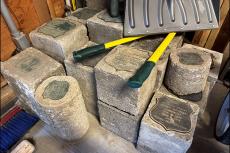As East Hampton Town officials labor to alleviate the scarcity of affordable housing, the president of a nonprofit community development organization pitched its assistance to property owners in financing the creation of accessory dwelling units, or A.D.U.s, to the town board on Tuesday.
Gwen O’Shea of Community Development Long Island, which provides programs like rental assistance, home improvement optimization, and counseling and guidance programs for prospective home buyers, detailed the Plus One A.D.U. program, which supports single-family homeowners who wish to build a new unit on their property or improve one that must be brought into compliance with local codes.
The program, Ms. O’Shea said, “is targeted for municipalities that have existing A.D.U. codes on the books” and recognize “the critical need we have to develop more housing across the state, and in particular on Long Island. This was a great way to start expediting getting funds out for communities that were willing and interested in moving forward with that.”
The Plus One program provides up to $125,000 in the form of a forgivable loan, amortized over 10 years, to eligible and income-qualified homeowners to build or legalize an A.D.U. Community Development Long Island offers support in unit design, permitting, and construction costs, including oversight and closeout.
“We work very closely with the appropriate departments and agencies throughout all the different municipalities that we’re working with,” Ms. O’Shea said. The development group recognizes that standalone A.D.U.s can require an upgrade to a property’s septic system, and that “there may need to be additional funds beyond the $125,000 that are available through the program” for that upgrade.
Annual household income must be below the Nassau-Suffolk County area median income in order to be eligible for the program, Ms. O’Shea said. “The program is really meant for those who may not have access to other funds,” she said. Creating an A.D.U. not only puts new units online but also provides “additional financial support for that homeowner to really be able to take care of their financial needs.”
The property owner can live in the primary residence or the affordable unit, but the property must be both the owner and the renter’s year-round residence. The property owner is also required to rent the unit for 10 years and be subject to annual checks to ensure compliance.
“The idea is not to create new, additional Airbnbs or weekend rentals,” Ms. O’Shea said. “The funds are intended to put new units online to help support not just homeowners, but also the community economic development aspect, as well helping to support the work force and other individuals that are critical to the community.”
Applicants can choose five or 10-year loan terms and will work with local contractors.
New York State’s Homes and Community Renewal agency selected Community Development Long Island to administer the Plus One program in Southampton, Shelter Island, and Babylon Towns, Ms. O’Shea said, and interest has been high in each municipality: 200 applications have been received from Southampton, with 70 approved. There are 20 approved applications on Shelter Island, and 85 in Babylon.
The development group offers design guidelines specific to the municipality so that property owners understand what is allowable to build. In Babylon, for example, standalone A.D.U.s are prohibited.
Before Ms. O’Shea’s presentation, Eric Schantz, director of the town’s Office of Housing and Community Development, told the board that he had spoken with a counterpart in Southampton Town who “had nothing but good things to say about the process and their experience with it. So it’s something that I think the town board should explore.”
The Plus One program would not replace any of the town’s affordable housing initiatives, Mr. Schantz said during his own presentation of the town’s efforts to encourage the creation of affordable units. Rather, “it’s an alternative funding source that’s available to homeowners that qualify. And given the good experiences of other municipalities with it, it’s something that I think we should venture into, to provide an option for funding for construction of apartments as soon as possible.”
The town, Mr. Schantz reminded the board, has also moved to incentivize property owners to create such units. A limit of 20 per school district has been raised to 40. A minimum parcel size of 30,000 square feet to create a detached unit has been lowered to 20,000 square feet, and property owners can opt to live in the primary residence or the affordable unit while renting the other. A residency requirement for tenants has been waived, an effort to provide seasonal housing. Likewise, up to five seasonal rentals per school district are now allowed.
An A.D.U. can now have two bedrooms, whereas only one was previously allowed. Owners of the units can now charge rent equal to 130 percent of fair-market value as designated by the federal Department of Housing and Urban Development, where the maximum was previously 110 percent.
“That helps the homeowner be able to get more money from renting this out,” Mr. Schantz said, “while still keeping the rent within an affordable range for a tenant.” The application process has been updated and streamlined, he said.
East Hampton voters passed a community housing fund proposition last year, which authorized a .5-percent tax on some real estate transfers in addition to the 2-percent transfer tax on real estate transactions for the community preservation fund. It is projected to raise $4 million to $6 million in 2024. Mr. Schantz said his department and the community housing advisory board will soon provide information to the public as to how to apply for funding to create affordable units.
“Ultimately, I’d like to see a portion of the community housing fund reserved for a specific subprogram” to provide for such units, he said.



